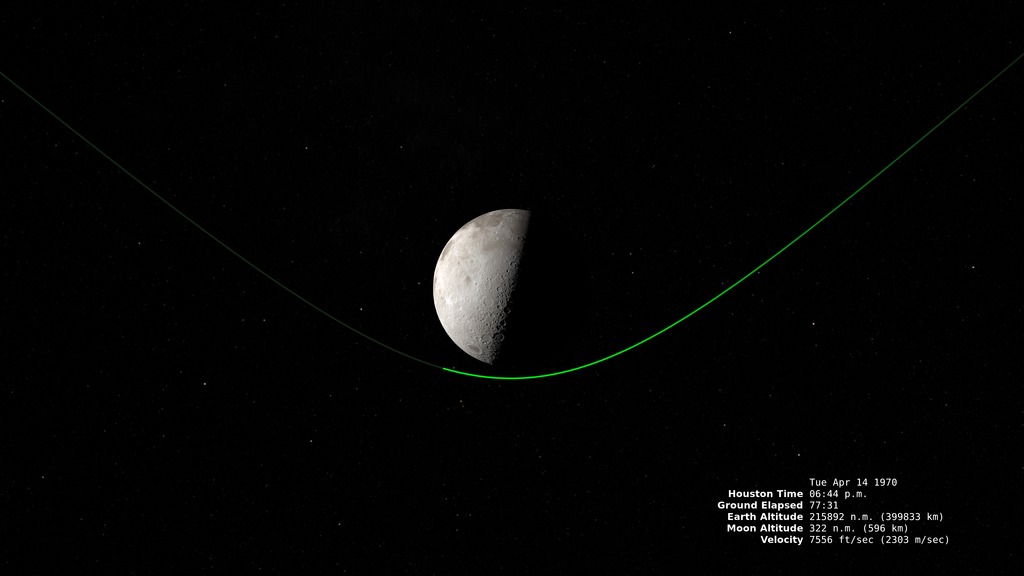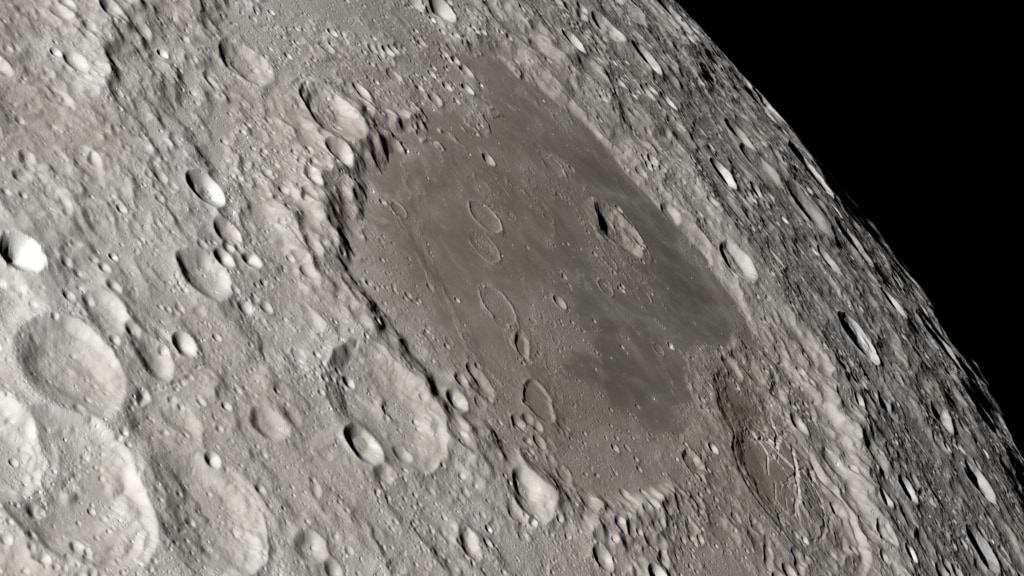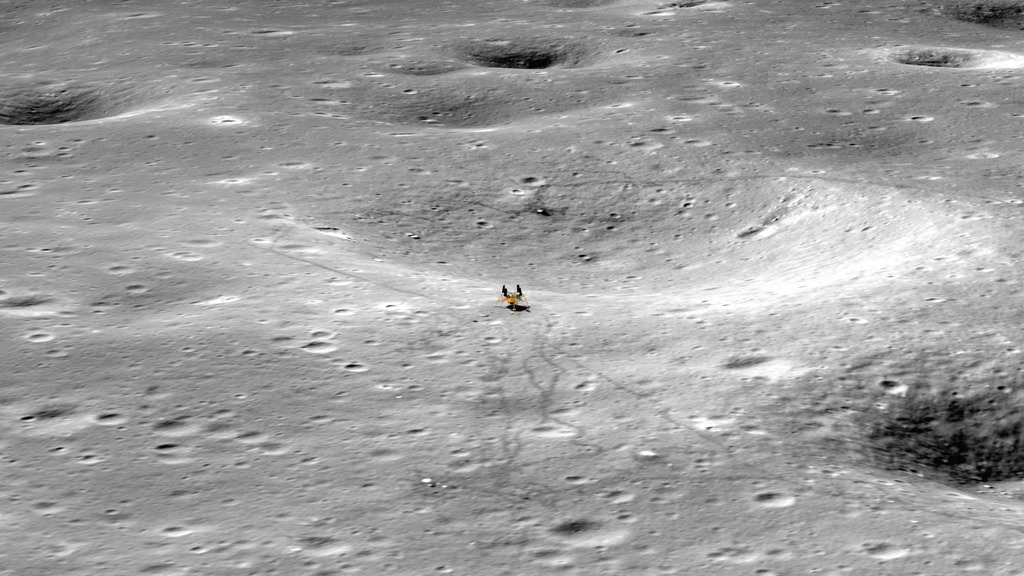Apollo 13 S-IVB Impact Site
The impact of the Apollo 13 S-IVB is seen as a brief flash on the night side of a waxing gibbous Moon. The camera then flies very close to the surface to show an LRO image of the impact site.
Seventy-eight hours into the flight of Apollo 13, Capcom Vance Brand in Mission Control informed the astronauts that the third stage of their Saturn V rocket had hit the Moon. Commander Jim Lovell replied, Well, at least something worked on this flight.
One day earlier, a catastrophic failure of an oxygen tank in the Service Module left the crew without power, air, and water in their Command Module, forcing them to use their Lunar Module as a lifeboat. The Moon landing, and all of the science they would do on the lunar surface, was lost. The only major science objective that yielded results was the intentional impact of their booster.
After sending the astronauts out of Earth orbit on a path to the Moon, the detached upper stage of the Saturn V rocket, called the S-IVB (“ess four bee”), was aimed squarely at the Moon. Its impact at 77:56:39.7 mission elapsed time was detected by several scientific instruments left on the surface by Apollo 12. A seismometer (a moonquake detector) recorded the tremor, and particle detectors sensed molecules from both the impact itself and the resulting deflection of the solar wind.
More than four decades later, the Lunar Reconnaissance Orbiter (LRO) mission located and photographed the Apollo 13 S-IVB impact site about 135 kilometers west of the Apollo 12 landing. In this visualization, we first see the location of the impact on the night side of the waxing gibbous Moon. (It isn’t certain whether the impact could have been seen from Earth in this way, but the energy of the impact was roughly twice that of the bright flash recorded on March 17, 2013.) The view then zooms rapidly to the LRO image of the impact crater before pulling back to show its location relative to the Apollo 12 landing site.
The close-up NAC (Narrow Angle Camera) view is a detail from image M140087684L and has a resolution of 50 centimeters per pixel. The wider view, at 100 meters per pixel, is a detail from the LROC WAC global morphological map.
The raw frames of the animation, without text overlays or freeze frames.
VIDEO: "The Apollo 13 Booster Impact Experiment"
The story of Apollo 13 goes beyond a tale of survival. The mission also successfully completed a science investigation that is still helping to inform our understanding of the Moon to this day. Early in Apollo 13’s voyage, Mission Control sent the spacecraft’s empty S-IVB rocket booster on a collision course with the lunar surface, where a seismometer set up by the Apollo 12 mission would measure the tremors. This video highlights the beginning and end of that impact experiment, and shows how current data and imagery from NASA’s Lunar Reconnaissance Orbiter mission helps us better interpret and analyze the results.
This video not only contains archival footage captured by the crew of Apollo 13, but also newly-uncovered audio of a humorous exchange between astronauts Jim Lovell, Fred Haise, and Capcom Vance Brand at Mission Control. This booster impact experiment audio had been recorded and sent to the National Archives and Records Administration in 1970, but was unplayable at that facility due to differences in audio equipment, so it sat in storage. The only machine capable of playback is located at NASA’s Johnson Space Center, but that equipment had been out of service for decades. In 2015 an effort funded by the National Science Foundation saw the equipment refurbished, and all 7,200 hours of Apollo 13 audio was digitized. This material was first made publicly available in early 2020 at ApolloInRealTime.org. Among this never-before-heard material we were able to find the conversation covered in this video.
This video also utilizes images from the Lunar Reconnaissance Orbiter Camera (LROC) as well as a data visualization of the Moon showing the locations of the booster impact experiment relative to the Apollo 12 seismometer station. The network of seismometers set up during the Apollo era, combined with data from the LRO mission, is teaching us about moonquakes and the interior structure of the Moon. This information will be useful to all future NASA missions to the lunar surface.
Music Provided by Universal Production Music: "Trust" - Jose Tomas Novoa Espinosa
Apollo 13 footage and audio provided by: ApolloInRealTime.org
Watch this video on the NASA Goddard YouTube channel.
Credits
Please give credit for this item to:
NASA's Scientific Visualization Studio
-
Visualizer
- Ernie Wright (USRA)
-
Producer
- David Ladd (USRA)
-
Video editor
- David Ladd (USRA)
-
Scientist
- Noah Petro (NASA/GSFC)
-
Technical support
- Laurence Schuler (ADNET Systems, Inc.)
- Ian Jones (ADNET Systems, Inc.)
Release date
This page was originally published on Monday, April 6, 2020.
This page was last updated on Wednesday, November 15, 2023 at 12:15 AM EST.
Missions
This visualization is related to the following missions:Datasets used in this visualization
-
NAC (Narrow Angle Camera) [LRO: LROC]
ID: 652 -
DEM (Digital Elevation Map) [LRO: LOLA]
ID: 653 -
LROC WAC Global Morphological Map (Global Morphological Map) [Lunar Reconnaissance Orbiter: Wide-Angle Camera]
ID: 926
Note: While we identify the data sets used in these visualizations, we do not store any further details, nor the data sets themselves on our site.


